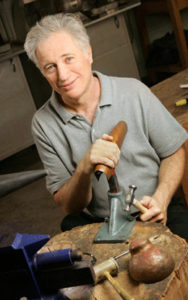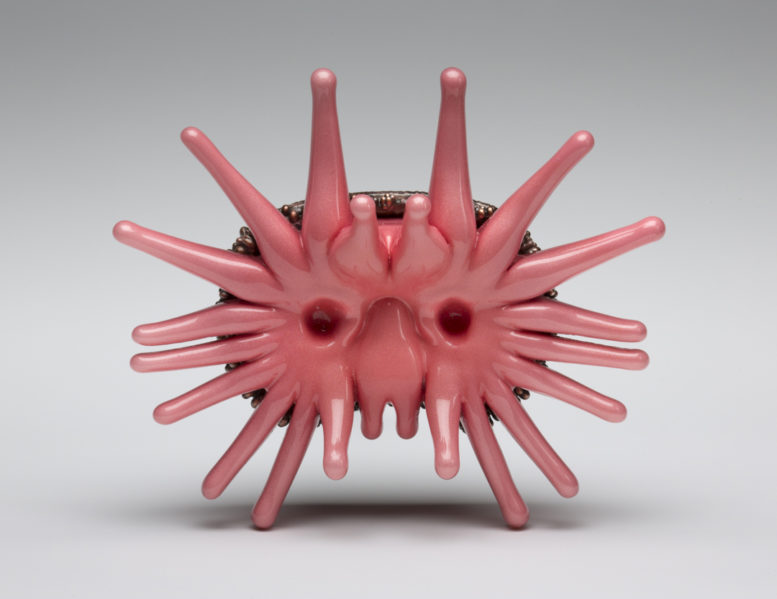By DAVID DUPONT
BG Independent News
Making a belt buckle is not as simple as it seems, and it has taken master jeweler and metalsmith Tom Muir decades to get around to the task.

Tom Muir (Image provided)
Muir, who has taught in the Bowling Green State University School of Art for 25 years, said as a graduate student in the early 1980s he did try his hand at it. “But it never worked out quite right.”
Even as he pursued other work that landed him recognition as one of the nation’s top jewelers, including an ornament on the White House Christmas tree in 1993, the challenge of making a belt buckle was in the back of his mind.
Recently a technical and aesthetic considerations aligned, and he started creating belt buckles.
And those are some buckles. One just won the World Champion Belt Buckle Competition. What’s the prize? A $250 in cash and a belt buckle, of course. Buckles are often awarded from traditional masculine activities, such as hunting and fishing and more recently barbecuing, Muir noted. (Making belt buckles may not be so gender-specific – one of Muir’s former students, Marissa Saneholtz, a BGSU and Bowling Green High graduate, received an honorable mention in the competition.)
An avid amateur naturalist, Muir has been using forms from nature in his most recent work. He made one designed like a pig’s snout, a nod to competitive barbecuing. In the case of the winning entry, he used the snout of a star-nosed mole for the buckle.
In a statement for an exhibit Naughty Narrative (another former student from Bowling Green, Andrew Kuebeck, curated the show) Muir explained the attraction of the mole’s nose.
“This busy, inscrutable animal living in fertile darkness makes a marvelous emblem of the human unconscious or dream life. And its nose combines in a single form the tender vulnerability of a revealed secret with a plethora of foldings in which a sensual mystery appears to dream.”
The artist sees even more. The soft, fleshiness of the snout evokes human genitalia, male and female. That’s played up by the placement of the buckle just about the groin.

AndrewKiebeckmodelspig snout belt buckle. (Image provided)
For men, this makes the buckle, like other adornments, a symbol of the wearer’s social status. The showy quality of the trophy buckle relates, Muir said, to his interest in body language. That’s all the more obvious during political campaigns.
Experts, he said, have compared the way certain male politicians carry themselves to the way dominant chimpanzees strut about. That’s evident in the way Donald Trump presents himself, he said.
“I’ve always been interested in body language and the way people dress, and things that signify who they are in society,” he said
Muir takes that even further back into history, to the codpiece, a far older and more obvious kind of masculine adornment. Henry the VIII wore one. The thugs in “A Clockwork Orange” wore them.
Muir is making them and will encourage his students to try their hands at codpieces.
Beyond the weighted symbolism of the belt buckle, are technical challenges. “A belt buckle requires a little more skill and planning in terms of how the belt is attached,” he said. When he first tried making buckles as a graduate student that was the hang up.
Some artists may just purchase fasteners to attach it to one end of the belt and then hook it to the other end. Muir designs his own.
“To make that work properly and then to attach to the belt requires a lot more strategic thinking and design and workmanship. It takes a lot of careful measurement,” he said.
He also had the belts themselves crafted for him, by one of his graduate students, Dinu Gavris, who dyed the leather pink.
Muir has been exploring the use of digital modeling, combining digital technology with traditional art techniques. This has implications not just for art, but also for industrial design, he said.
Next semester he will be teaching Virtual Form/Tangible Object for the fourth time since 2009. The class will be looking up to focus on adorning a different part of the body, “Eyewear in the Digital Age.”



